

COOL THINGS YOU CAN MAKE WITH OLD BOOKS – Bookish Buzz. How Libraries Can Turn Stories Into Maker Projects. Peters said she always tries to elevate the idea of “book-based craft” by finding a way to make each project less cookie-cutter. Projects are meant to be in the hands of the reader, not a facilitator, so they differ from the typical prompts children might find at the end of books. Her goal is “to make a visible connection between the value of hands-on learning and the value of introducing literacy at a young age and how those two can support each other.” She’s mostly using children’s books, but Peters wants the instructions to work for people of any age.
To make sure pre-teens are not put off by using children’s books, Peters was careful with her language. For instance, instead of printing “go ask your parents,” instructions state, “find these materials.” In the past couple of months, Peters has completed 15 of these book-based maker projects and has received positive feedback from parents and patrons. How to Make a Simple Box Loom Weaving. My older daughter, age six, is obsessed with fiber arts, and has been engaged in all sorts of weaving activities lately.
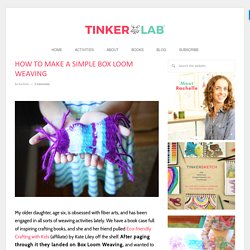
We have a book case full of inspiring crafting books, and she and her friend pulled Eco-friendly Crafting with Kids (affiliate) by Kate Liley off the shelf. After paging through it they landed on Box Loom Weaving, and wanted to give it a go. The tutorial is very well articulated, and once we gathered all the materials (and there are only seven supplies…phew) we had no trouble tackling this easy and rewarding weaving project. I’ll share all the steps here. Book Creator. 4 Strategies to Define Your Makerspace Goals. I want to start a makerspace.
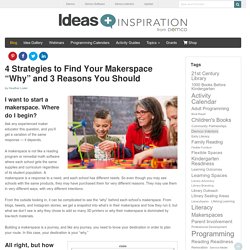
Where do I begin? Ask any experienced maker educator this question, and you’ll get a variation of the same response — it depends. A makerspace is not like a reading program or remedial math software where each school gets the same supplies and curriculum regardless of its student population. Creating Makerspaces for All: Lessons From the Experts. 25 Makerspace (STEM / STEAM) Projects For Kids. Makerspace or STEM projects for kids don’t have to be complicated or expensive. In fact, some of the best projects use recycled or repurposed items like cardboard or soda bottles which means nothing to buy. Cranky Contraption Exploration – TODDBURLESON.COM. I have become somewhat obsessed with the concept of automata over the past month or so.
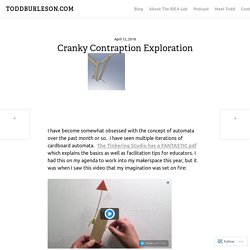
I have seen multiple iterations of cardboard automata. Three Reasons Why You Should Let Kids Get Splinters at School! – TODDBURLESON.COM. Let me preface this post by saying, if I got you to find your way here, I want you to know that I don’t necessarily favor letting kids get splinters.
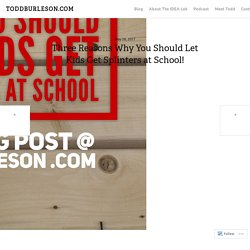
However, if they get them in the act of doing something super meaningful and fun, I think it’s definitely worth it! Several weeks ago my colleague, Gary Wendt, shared with me that he had found some benches on Amazon to fit in the music room hallway. We need benches there because students wait in that hall during the switching of classes several times a day. Almost impulsively I blurted out, “Don’t buy them! Let’s have the kids build them!” How We Created a Makerspace – TODDBURLESON.COM. This post is a cross-post from eSchool News published on March 20, 2018 [Editor’s note: Welcome to our new series, The New Librarian.
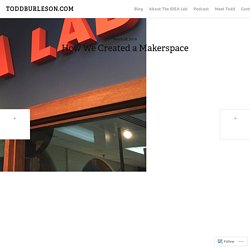
In this series, we will be profiling innovative and award-winning library media specialists who will share their favorite tools, lessons, and advice. The Classroom or Library as a Makerspace – JackieGerstein Ed.D. Makerspaces, Maker Education, STEM, and STEAM are gaining lots of traction in Kindergarten though college level education.
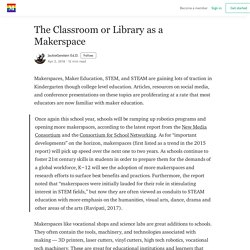
Articles, resources on social media, and conference presentations on these topics are proliferating at a rate that most educators are now familiar with maker education. Once again this school year, schools will be ramping up robotics programs and opening more makerspaces, according to the latest report from the New Media Consortium and the Consortium for School Networking. As for “important developments” on the horizon, makerspaces (first listed as a trend in the 2015 report) will pick up speed over the next one to two years.
As schools continue to foster 21st century skills in students in order to prepare them for the demands of a global workforce, K–12 will see the adoption of more makerspaces and research efforts to surface best benefits and practices. The faces of School Library Makerspaces: Teacher Librarians Jackie Child and Megan Daley - AACE. What is a makerspace?
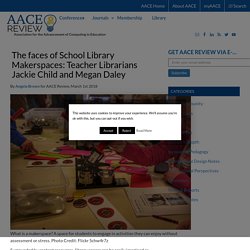
A space for students to engage in activities they can enjoy without assessment or stress. Photo Credit: Flickr 5chw4r7z Surrounded by content resources, library spaces can be easily imagined as content creation spaces. 25 Makerspace (STEM / STEAM) Projects For Kids. Laura Fleming: Don’t Let Makerspaces Be A Passing Trend. Moving Beyond Lego Walls - Worlds of Learning.
In my newest book, The Kickstart Guide to Making GREAT Makerspaces, I talk a lot about how educational makerspaces schould be unique, meaningful and relevant to their school communities and point out that: No two makerspaces should be exactly alike, because no two school communities are exactly alike. All too often, school districts just replicate what others are doing or base their decisions on makerspace trends. Maker Movement Grows in K-12, with Librarians Leading the Way, Finds SLJ Survey. Illustration by Traci Daberko Old-fashioned board games and puzzles are what first drew students at a Jacksonville, NC, middle school into the library’s maker space.
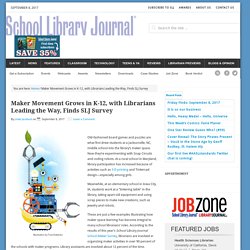
Now they’re experimenting with Snap Circuits and coding robots. At a rural school in Maryland, library participation has increased because of activities such as 3-D printing and Tinkercad design—especially among girls. Meanwhile, at an elementary school in Iowa City, IA, students work at a “tinkering table” in the library, taking apart old equipment and using scrap pieces to make new creations, such as jewelry and robots. These are just a few examples illustrating how maker space learning has become integral to many school librarians’ roles.
Robust collaboration with teachers About three-quarters of librarians overall say they coordinate maker activities with other teachers, with elementary-level librarians more likely than those in middle and high school to report such collaboration. Don’t Leave Learning Up to Chance: Framing and Reflection. Jackie Gerstein is an experienced educator who has been working as a classroom teacher and pre-service teacher trainer for years.

With a background in experiential learning, Gerstein is excited about current trends in education that have more people excited to try project-based learning, maker education and other approaches that let students get hands-on with their learning. She hopes all the excitement turns into robust, meaningful change in how mainstream teachers educate. To do that, she says it’s crucial that teachers not only focus on the materials and tools of a maker activity, but also carefully frame it and reflect upon it to make sure learning happens. Don’t Leave Learning Up to Chance: Framing and Reflection. Five Ways to Ensure Real Learning Happens in Maker-Enhanced Projects. While not new, project-based learning has become a popular method to try and move beyond surface-level learning.
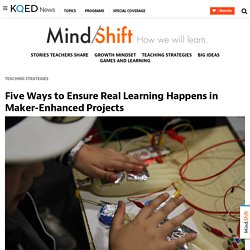
Many teachers are trying to figure out the right ingredients for strong projects that interest and engage students, while helping them meet required learning targets. But implementing project-based learning well isn’t easy, especially when many teachers are more accustomed to direct instruction, when they can be sure they’ve at least touched on all the topics in the curriculum. On top of the push toward projects, some educators are also embracing maker-education, a distinct but often overlapping idea. The Seven Myths Keeping Teachers from Designing Makerspaces - John Spencer.
In a previous post, I explored this idea that every student deserves a makerspace. In this post, I look at some of the most common myths I see regarding makerspaces. My Maker Story I first heard of makerspaces over a decade ago. It was a part of the do-it-yourself culture that I found intriguing. I visited a few places where people were doing high-tech fabrication and I wondered if I could somehow tie that into our economics unit where students were developing products.
But I got frustrated. How to Build an Awesome Makerspace Resource Library. Maker's Imagination The Beauty of Homemade Fun. By Kristina Holzweiss, School Library Journal Librarian of the Year, 2015 In my next life I will come back as an archaeologist, a female Indiana Jones on the quest for the lost relic of an ancient civilization.
For now, I am on the hunt for recyclable materials that my students can transform into works of art and engineering in our library makerspace. My own three young children (Tyler, 7; Riley, 5; and Lexy, 3) always know to ask Mommy before they toss anything into the trash. Soda cans, water bottles, cardboard, and packing materials are all resources that have the potential to become jewelry, flowers, cars, and forts. How to Turn Your School Into a Maker Haven. One of the best ways for frustrated parents, students and teachers to convince school leaders that it’s time for a reboot is with amazing student work. School Libraries and Makerspaces: Can They Coexist?
More and more schools are coming to value maker education and exploring ways to create makerspaces in their schools. Many schools are discussing how they might utilize their library to facilitate this. When Kids Engage In “Making,” Are They Learning Anything? Tuesday, May 12, 2015 A note to Brilliant readers: The following essay appears in the May issue of School Library Journal. The issue is devoted to making and maker spaces, and includes many interesting articles on the subject—I encourage you to check it out. ISTE 2015: Takeaway Tips for a Library Maker Space. Maker station at the ISTE Librarians Digital Age Playground at the 2015 ISTE conference in Philadelphia. Lego in libraries. This page aims to bring together a whole ton of information on lego in libraries in one place. ISTE 2015: Takeaway Tips for a Library Maker Space. Maker station at the ISTE Librarians Digital Age Playground at the 2015 ISTE conference in Philadelphia.
The maker movement was front and center at the 2015 ISTE conference—and that’s a good thing for me.